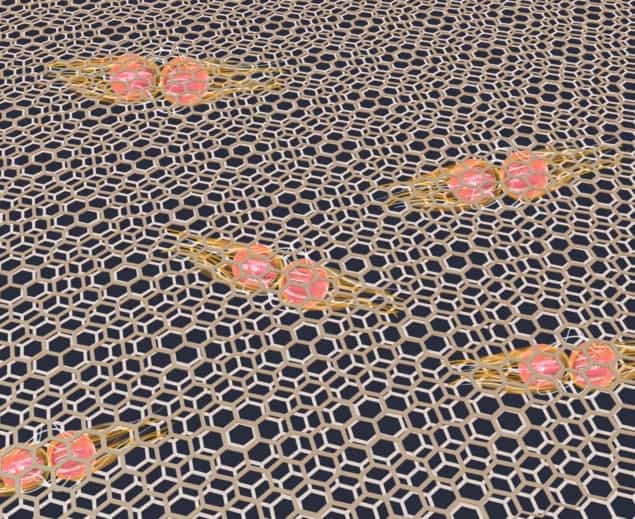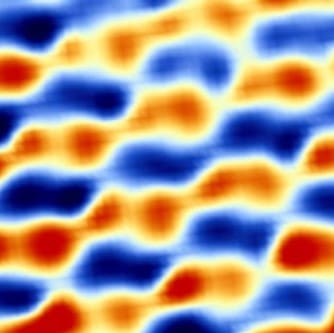
Amid the fanfare around the announced Mott insulating and superconducting states observed in magic-angle twisted bilayer graphene (TBG) in the spring of 2018, the real excitement was around the questions the results left unanswered – what were these states and what might they explain about other systems? By measuring the capacitance of magic-angle TBG Pablo Jarillo-Herrero (who led the research behind the observations announced in 2018) and Ray Ashoori, alongside colleagues at Massachusetts Institute of Technology (MIT) in the US and the National Institute of Materials Science (NIMS) in Japan, have now directly probed the density of states in these systems, as reported in Physical Review Letters. Fast on their heels three other collaborations reporting in three separate letters to Nature have studied these systems with scanning tunnelling microscopy and spectroscopy to provide the first microscopic images of what they look like.
Why worry about the density of states?
The energy states available to electrons dictate what momentum and wavelength and so on they can have, thereby determining the system’s electronic behaviour. Although not directly demonstrated in their experiments, when Jarillo-Herrero and colleagues reported Mott insulating and superconducting behaviour in magic-angle TBG a lot of people thought they were seeing signatures of “strongly correlated electron” behaviour, that is, interactions between electrons that are large compared to their kinetic energy. With its exceptional electron mobility, graphene might be the last place you would expect to find strongly correlated electrons. However, moiré potentials in TBG can alter the usual electron density of states.
Moiré patterns – a popular effect in fabrics – emerge wherever one mesh overlays another at a slight angle. Theory had suggested interesting effects from moiré bands at magic angles in TBG but it was not until Jarillo-Herrero’s group finessed the art of producing and studying these systems that the striking changes in behaviour with the magic angle of twist of 1.1° could be experimentally observed. By probing the density of states Jarillo-Herrero and Ashoori hope to understand the cause of these changes better.
Why capacitance measurements?
“Capacitance is a true thermodynamic measurement of the density of states,” Jarillo-Herrero told Physics World. “Earlier reports had measured some of the correlated gaps via transport techniques, but this is not a direct measurement.”
The capacitance experiments provide the first direct measurements of the density of states of magic-angle TBG, and give quantitative estimates of the gaps corresponding to two of the correlated insulator states, which are larger than transport measurements had suggested. In strongly correlated systems the energy of the electrons changes very little with momentum so that they appear to have a “flat dispersion band”. The capacitance measurements also indicate the width of this flat band and find it much higher albeit less flat than previously thought.
Producing devices sensitive enough for this kind of capacitance measurement is no mean feat but the researchers were able to draw on extensive expertise from Ashoori’s group. “When I was a postdoc at Bell Labs, I had the idea that we could use unpackaged commercial transistors to detect single electrons in a semiconductor,” Ashoori tells Physics World. “After testing out many transistors, I found the one with the least noise at low temperatures and in the frequency range where we make our measurements, and we still use that same kind of transistor. Other groups are now doing capacitance measurements with those same transistors.”
The expertise in Ashoori’s group means their future experiments could look at vertical structures where the charge tunnels into the 2D layer perpendicularly to the surface. “This has the advantage that we don’t need to have a path for charges to flow to any particular region of the graphene layer. Thus, in the vertical structures, we could detect charging even in the case where there is no lateral transport path to charge an area. These insulating regions may not have zero electronic density of states.”
Seeing is believing
Meanwhile several other groups have also been busy determining the true atomic and electronic structure of magic-angle TBG to help model and understand these systems better. In three simultaneously published reports, Jinhai Mao and Eva Andrei alongside co-workers at Rutgers University in the US, Ali Yazdani and colleagues at Princeton University in the US, and Angel Rubio and Abhay Narayan Pasupathy and researchers at Columbia University and the Flat Iron Institute in the US and Freie Universität Berlin and Max Planck Institute for the Structure and Dynamics of Matter in Germany – all in collaboration with Kenji Watanabe and Takashi Taniguchi at NIMS in Japan – have reported measurements of magic-angle TBG using scanning tunnelling microscopy (STM) and spectroscopy (STS).
The atomic structure of twisted bilayer graphene has a large impact on the electronic structure - Rubio and Pasupathy
These techniques hit the scene in the mid-1980s, providing the world with the first view of not just atomic structure but a glimpse of the electronic wave functions as well. They operate through measurements of the current that tunnels through the gap between a conducting tip and sample, and because this current is so sensitive to the topology and composition of the sample it provides exceptional spatial and energy resolution that subsequent developments of the technique have further enhanced.

How can we see individual atoms?
“The ability to visualize electronic wavefunctions using STM/STS will be critical to understanding the properties of this [magic-angle TBG] system,” Yazdani told Physics World, although he concedes that only a few groups have the resources and expertise the experiments require. Rubio and Pasupathy also highlight the technical challenges STM measurements pose, such as the precision needed to control the angle between twisted layers and the electrostatic doping of the micrometre-sized samples on polymer substrates. “From a theoretical perspective, the atomic structure of twisted bilayer graphene is quite delicate and has a large impact on the electronic structure,” they add. “Secondly, including the effect of electronic interactions on the electronic structure is a difficult task.”
However in terms of successful STM/STS experiments on magic-angle TBG, much of the ground work had been done already. “Our foray into moiré physics began serendipitously in 2009 with our work on chemical vapour deposition (CVD) graphene suspended on a transmission electron microscope grid – it turns out that these CVD samples contained a wide range of TBG regions with many different twist angles that produced moiré patterns,” explains Andrei, whose group were the first to carry out spectroscopic studies to elucidate how the moiré patterns observed in graphite at the invention of the STM affected the electronic properties. The studies revealed peaks in the density of states, a flat band at the magic angle 1.1 ° where “electrons come to an almost dead stop” and a gap at partial filling of the band, which “provided a tantalizing clue to the emergence of a correlated-electron phase”.
Converging conclusions
The STM/STS reports give the first view of what these systems look like at the nanoscale. The team led by Rubio and Pasupathy state outright that their “experimental observations illustrate that MATBG [magic-angle TBG] is a highly interacting problem, the physics of which cannot be captured with weak-coupling theoretical approaches”. In addition, the teams led by Mao and Andrei and by Rubio and Pasupathy highlight a break in the rotational symmetry of the moiré superlattice and local density of states.

Andrei describes how her team’s moiré work to identify this symmetry breaking was spurred on by “the spectacular discovery in 2018 of superconductivity in TBLG and its uncanny resemblance to cuprate high-temperature superconductors”, as well as Jarillo-Herrero’s student Yuan Cao’s “invention of an ingenious “tear and stack” method” to fabricate twisted bilayer graphene samples with control. “This led us to the discovery of a correlated electron phase in which the charge carriers in the sample organize themselves into a formation with alternating stripes of positive and negative charge,” says Andrei. “This stripe phase, which appears to be a precursor of the superconducting phase, could provide an important clue to the mechanism driving the superconductivity in this system and possibly in the cuprate superconductors.” The bilayer graphene system, which comprises just carbon atoms, could potentially provide a simpler system for studies to get to the bottom of what causes high-temperature superconductivity in these cuprates.
All three papers also confirm the conclusions from the capacitance measurements that the bandwidth is larger than previously thought. “It was very nice to see different techniques converging on answers to all of this,” says Jarillo-Herrero. “These three papers are a fantastic addition to the set of experimental papers already published.”
Healthy competition
The reports come just weeks after observations of ferromagnetism in TBG, highlighting that experimenting with the twist in these systems remains a fertile breeding ground for discovering new physics. “It is a “control knob” which had no precedent in the history of materials science,” says Jarillo-Herrero. “In condensed matter systems, every time you “explore a region” which has not been explored before interesting surprises are bound to happen”.

Why carbon is an amazing material – part two
The field has attracted the interest of a multitude of research groups, who have already reproduced and extended the initial results, which Jarillo-Herrero describes as “the best thing that can happen, as it shows that the effects are real, and that they represent the opening of a field.” This appreciation of the how the high level of competition and interest benefits the field is shared among the researchers. Yasdani adds that although competing now many of the STM groups have known and worked with each other for a long time, some having trained in his group.
Full details of the capacitance measurements are reported in Electronic Compressibility of Magic-Angle Graphene Superlattices and the scanning tunnelling measurements are reported in Spectroscopic signatures of many-body correlations in magic-angle twisted bilayer graphene, Maximized electron interactions at the magic angle in twisted bilayer graphene and Charge-order and broken rotational symmetry in magic angle twisted bilayer graphene.



